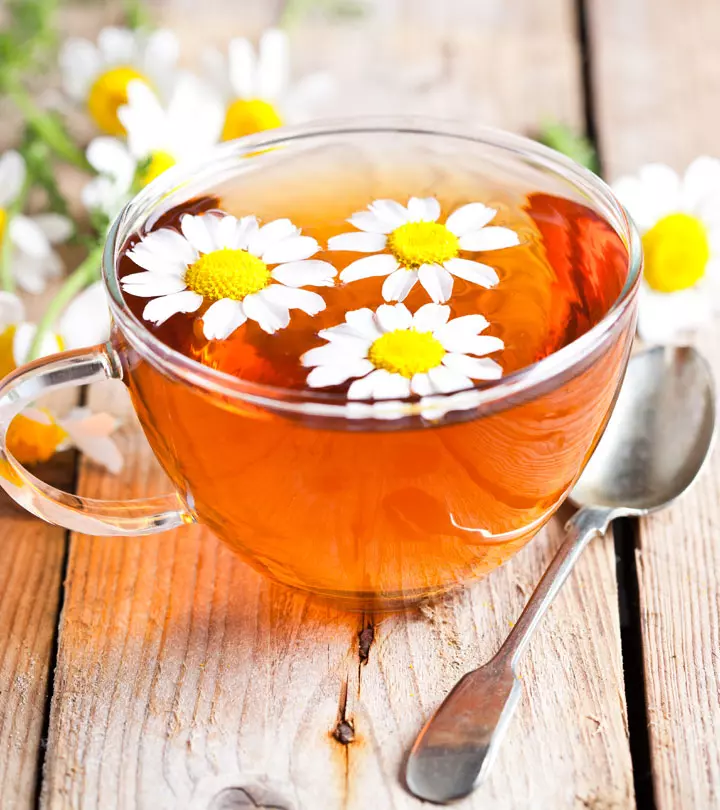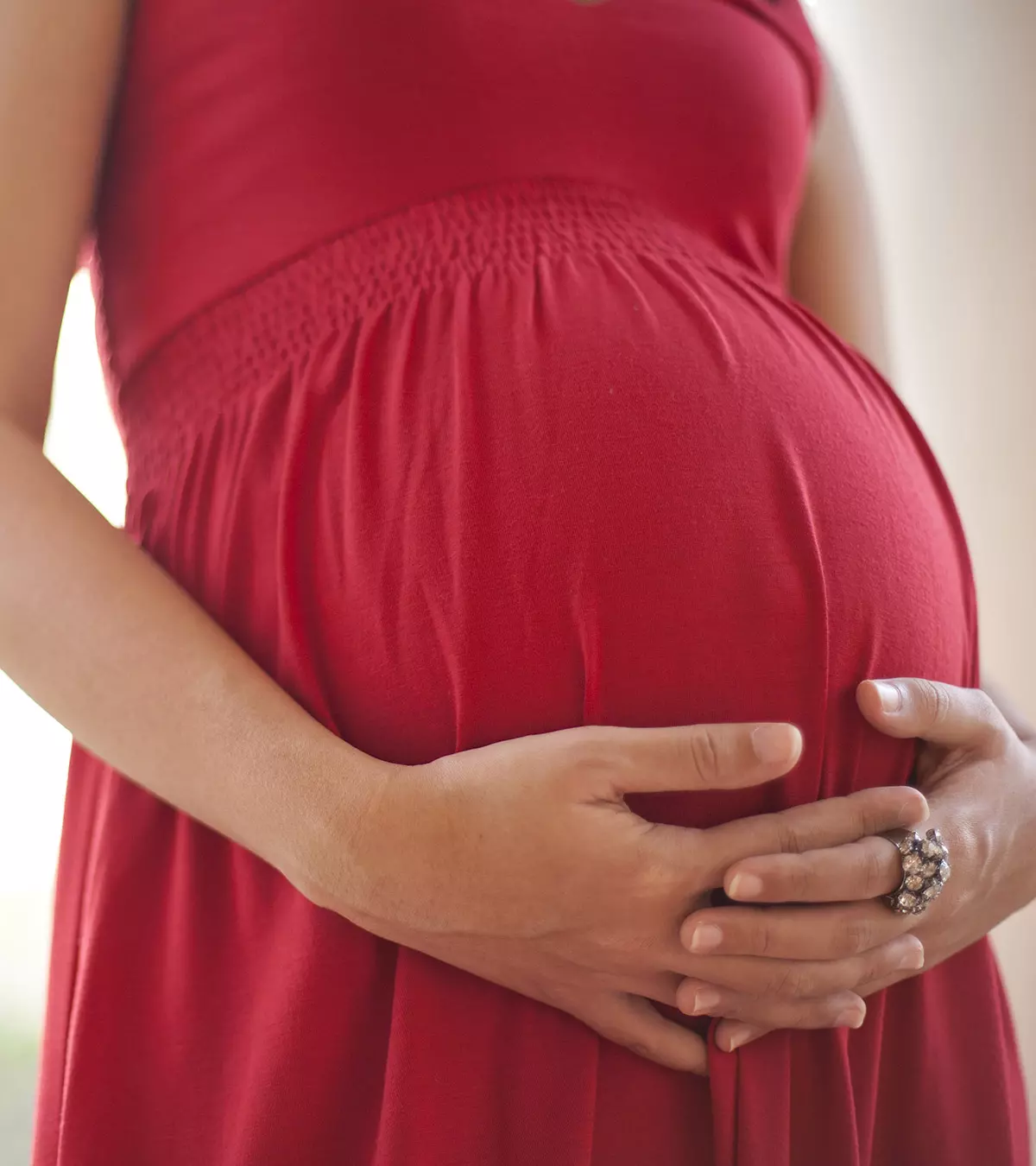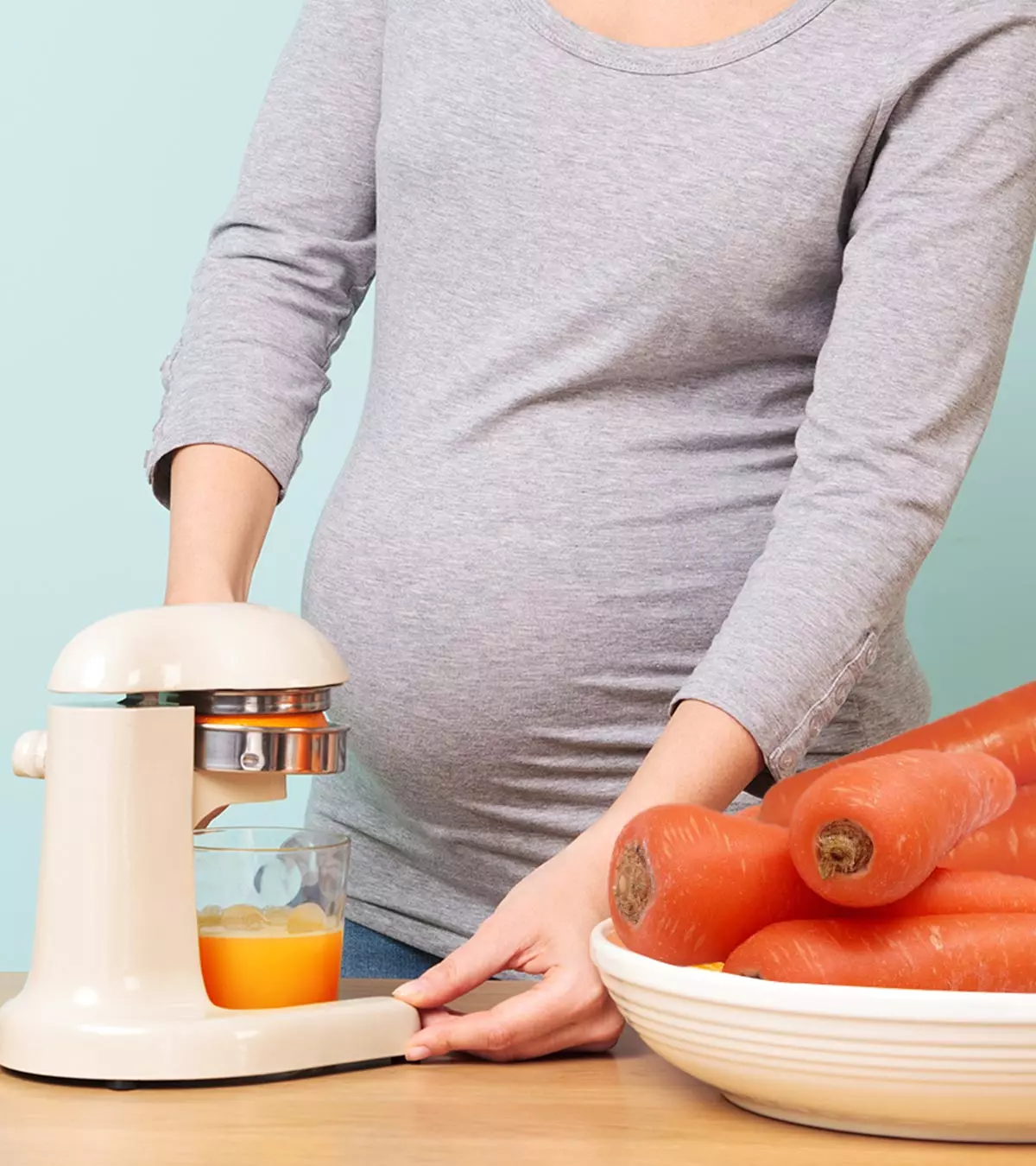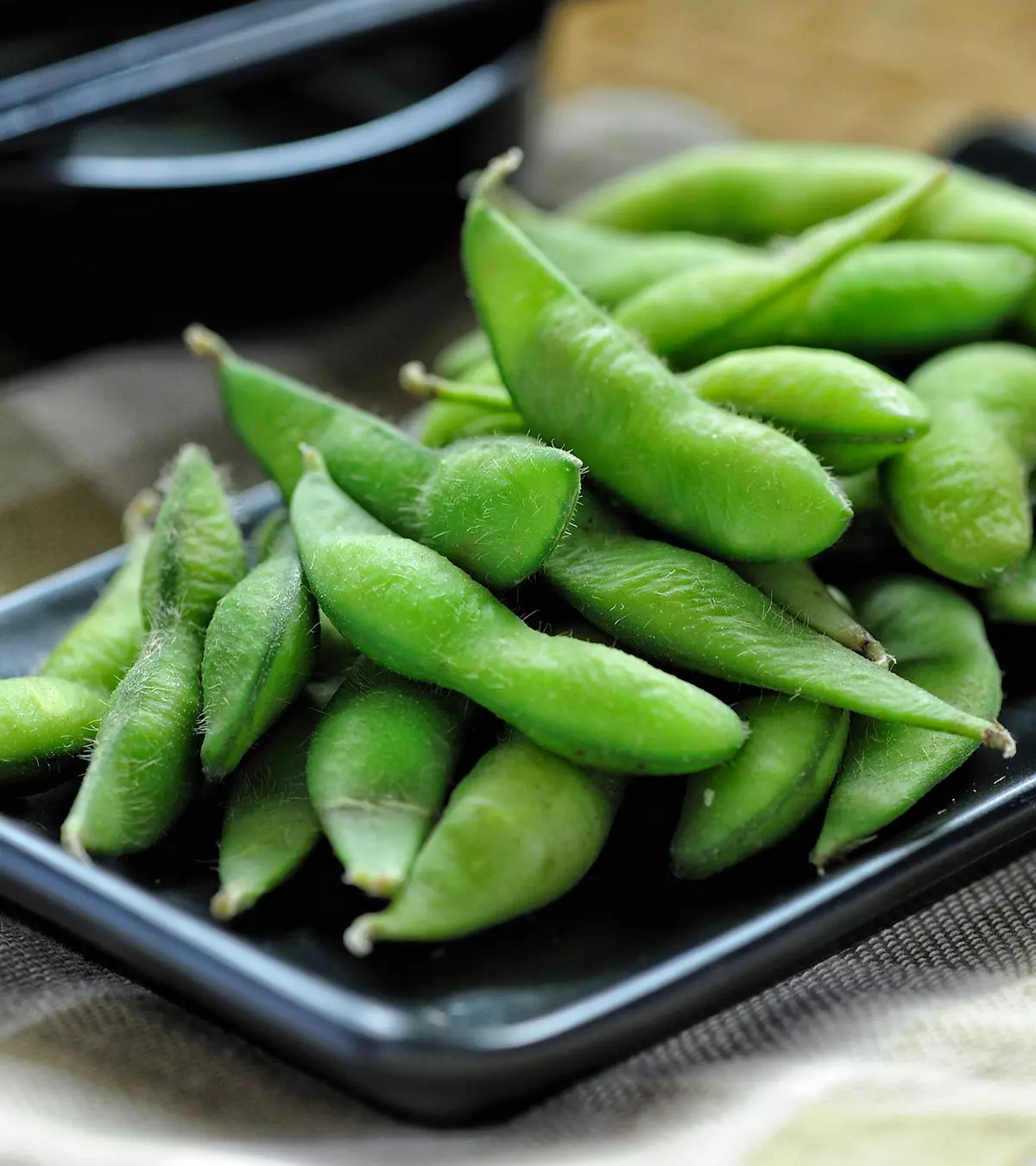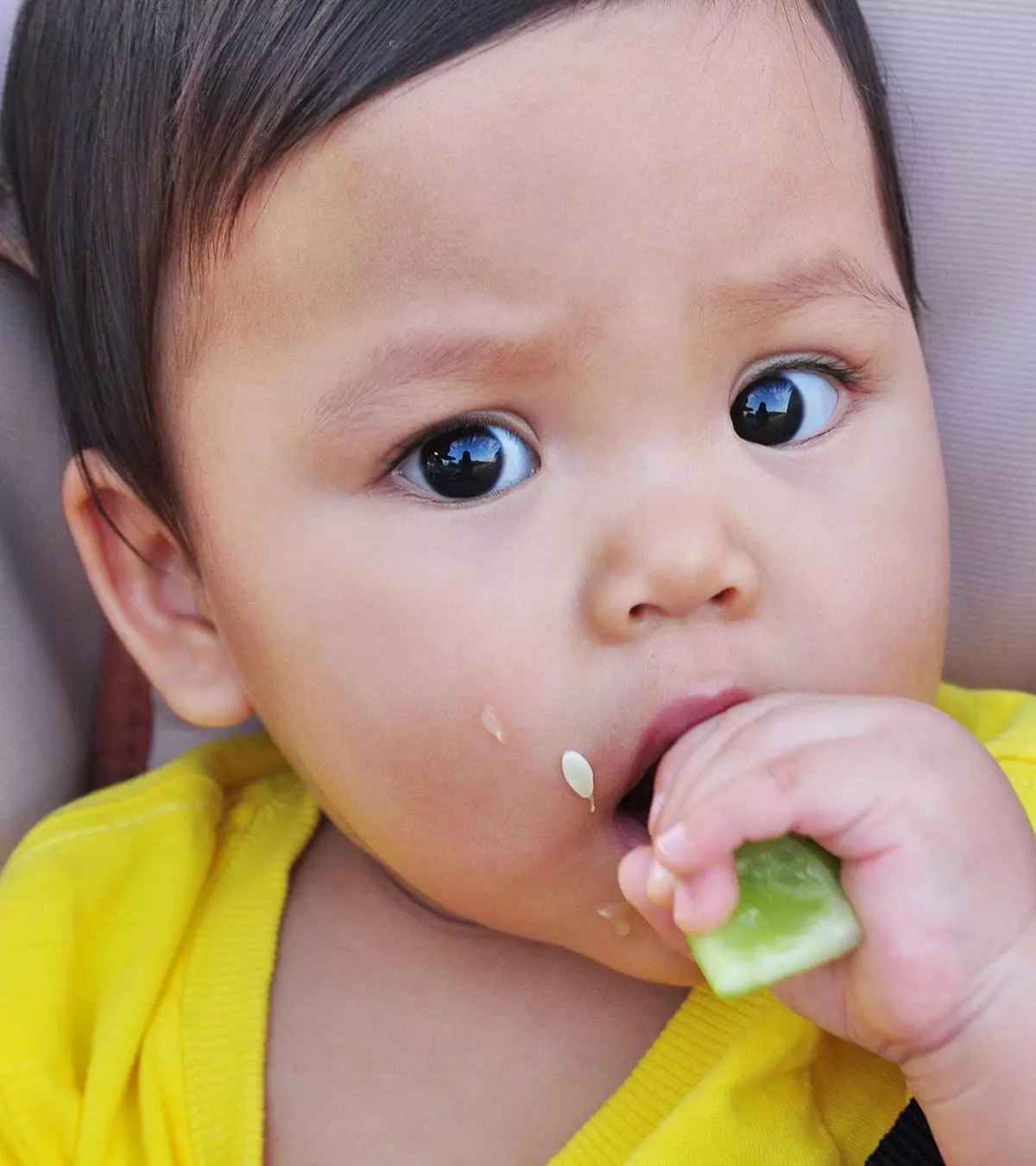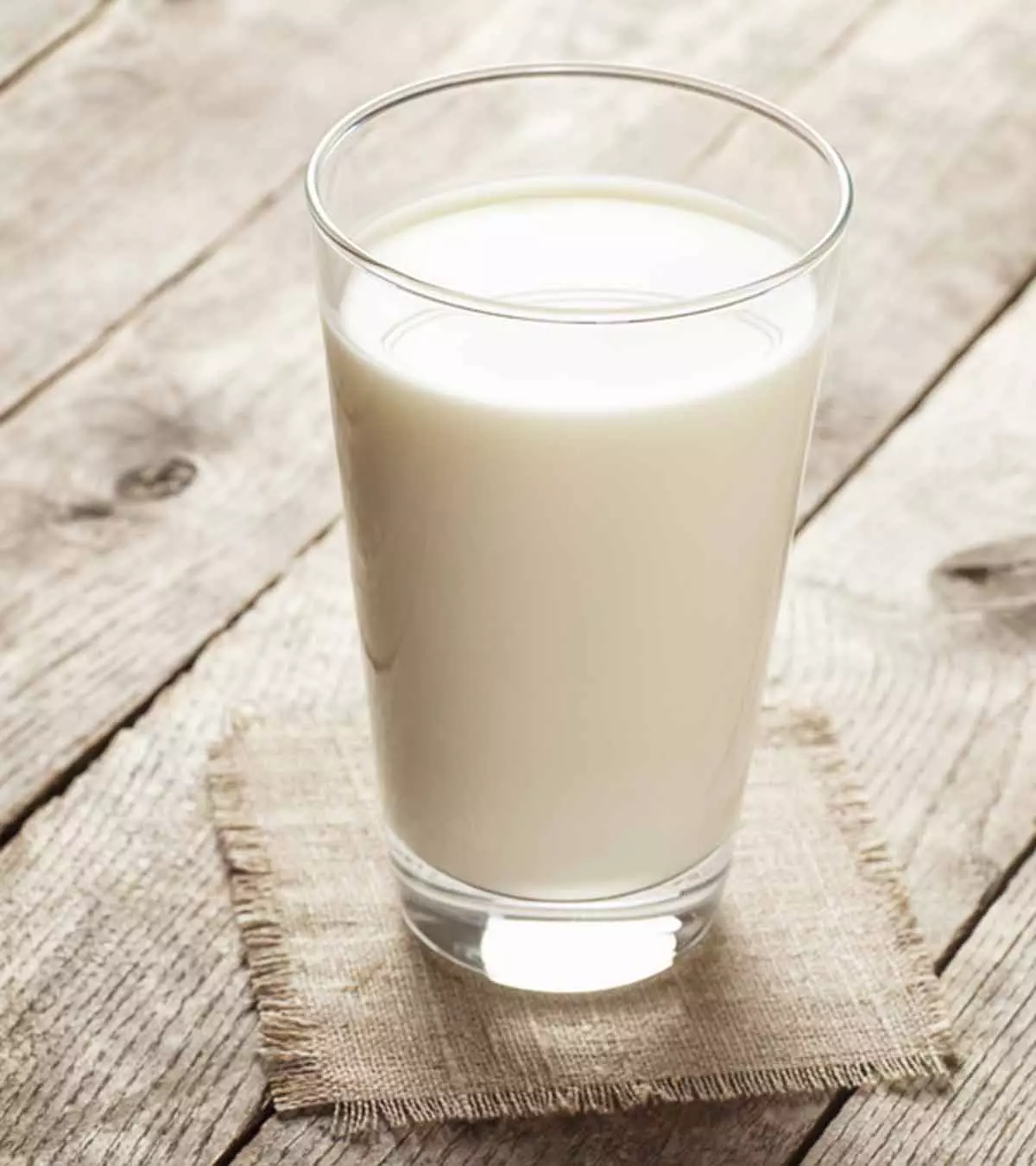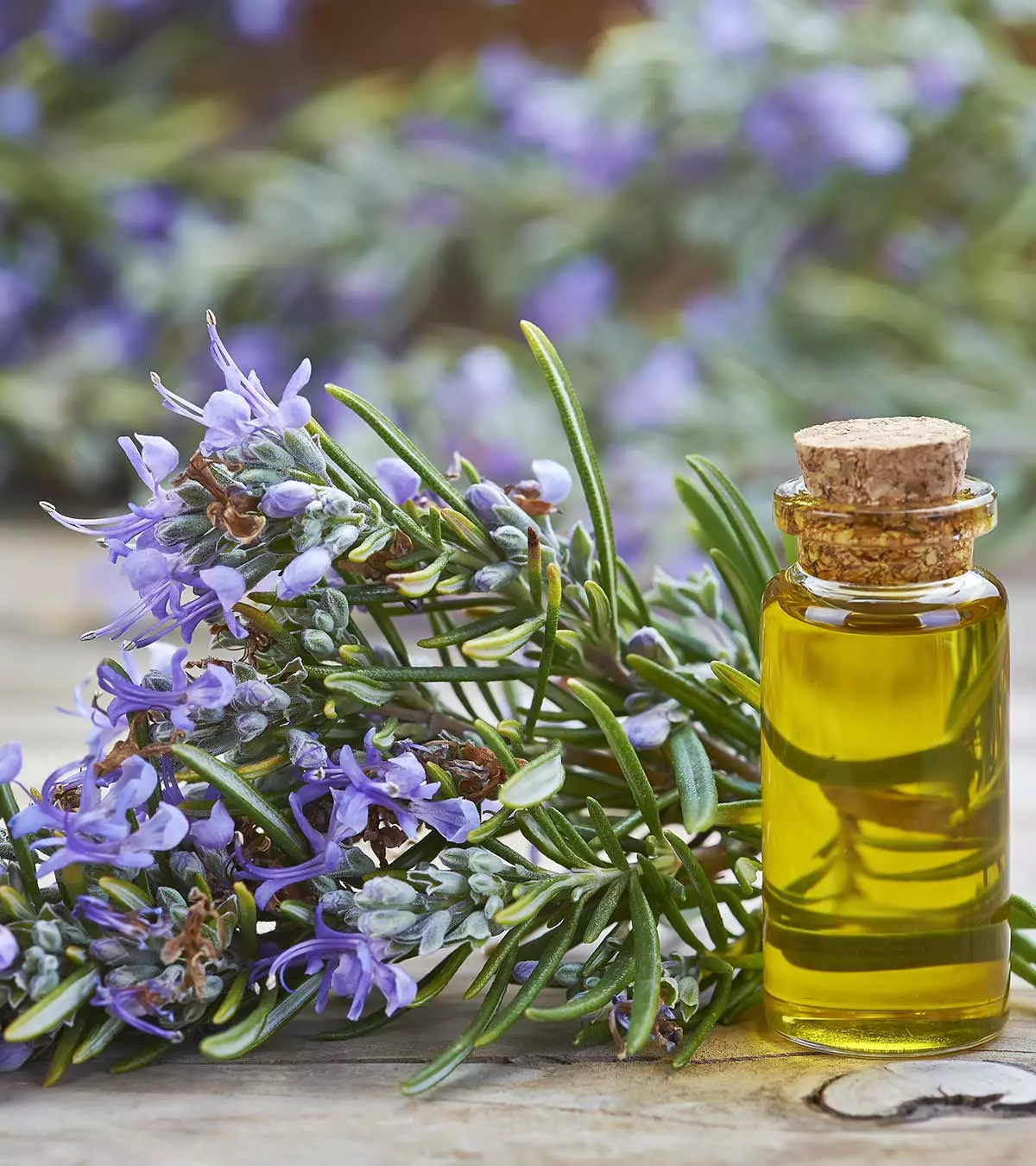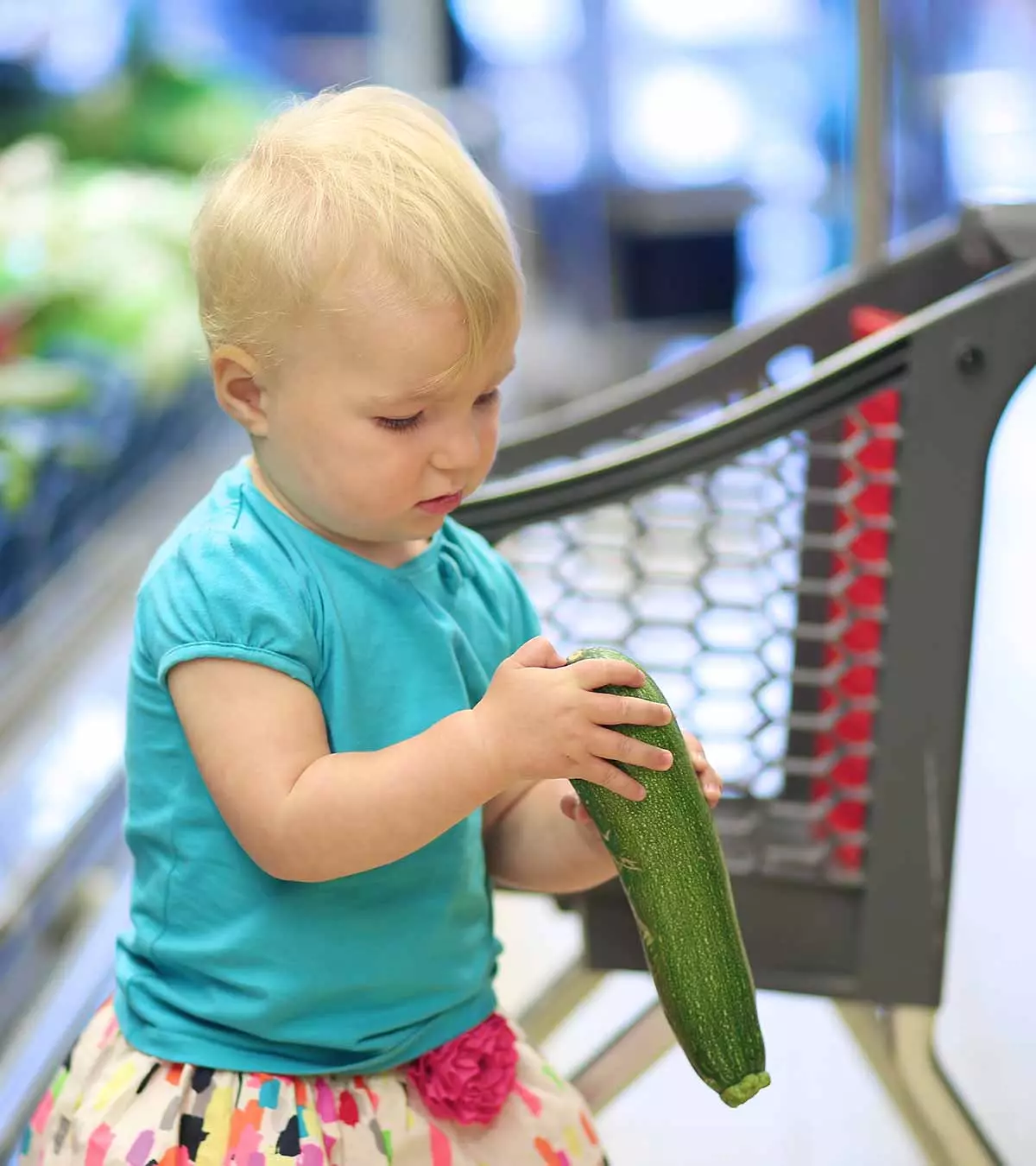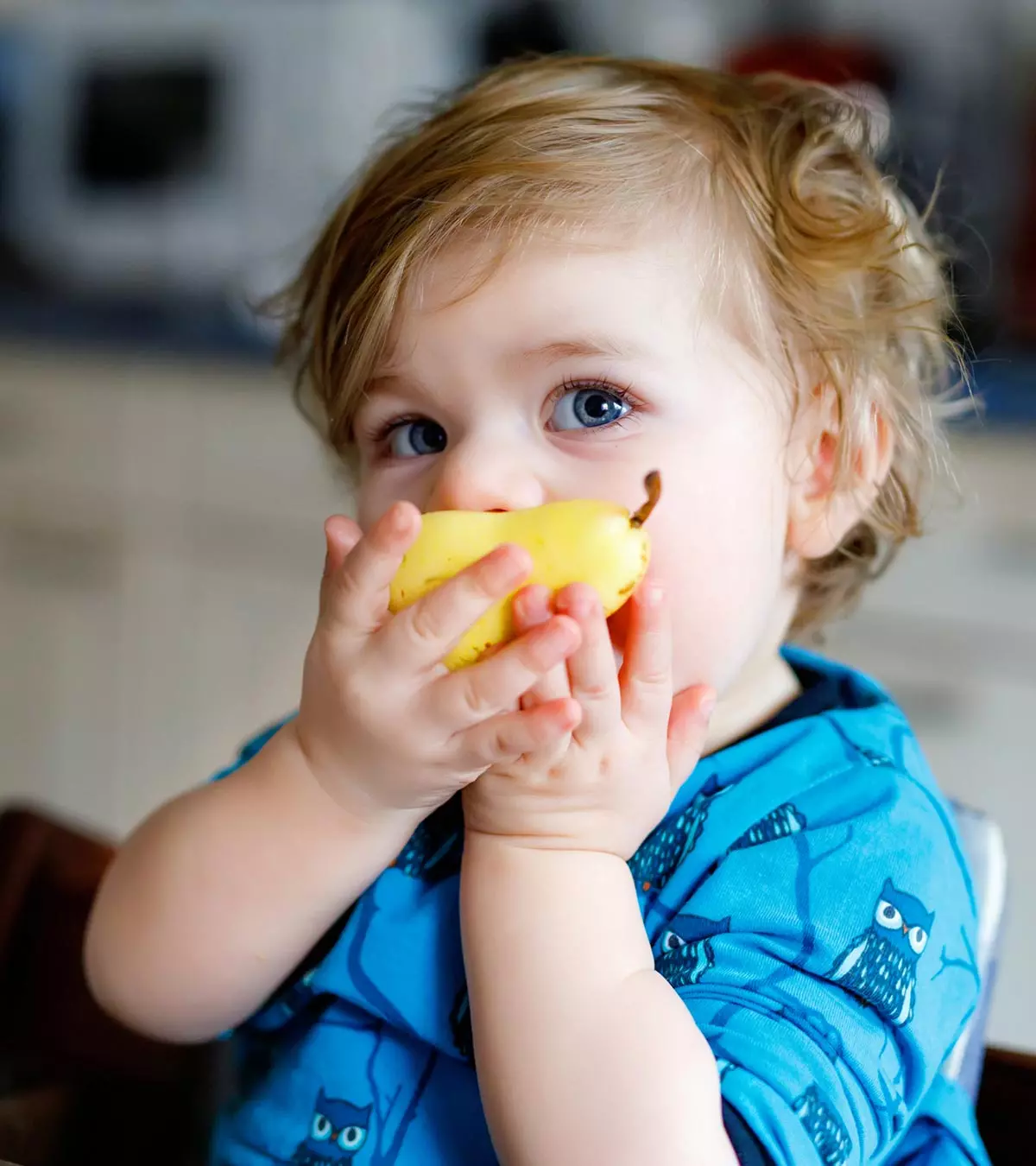
Image: iStock
Pears, the sweet bell-shaped fruit, can be consumed raw and cooked. It is a popular ingredient in most delicacies such as jams, jellies, juices, and cider. Nevertheless, you are bound to wonder if you could consider pears for babies.
Pears offer many important nutrients for an individual’s healthy growth and development. They are also rich sources of fiber and other phytochemicalsiNaturally occurring compounds in plants that provide health benefits to humans that possess medicinal properties, which may treat constipation and other illnesses. When consumed the right way, professionals suggest that pears have several benefits (1).
Read on to know about the right age to feed pears to babies, its health benefits, and a few recipes. We have also included a few tips for their selection and storage.
Key Pointers
- Pears are a good source of vitamins C and K.
- A moderate intake of pears reduces constipation and improves gut health due to its prebiotic properties.
- Introduce small quantities of cooked and mashed pears to babies, initially.
- Follow the three-day rule and observe your baby after the intake of pear for any signs of allergies.
- You may try pear puree, pear porridge, or pear yogurt recipes for babies.
When Can Babies Start Eating Pear?
Babies can start consuming pear as part of a balanced weaning diet at six months of age when they begin eating solid food (2)
. If you wish to start feeding pear sooner, consult your pediatrician first. You can initially feed peeled and cooked, steamed, or stewed pear as a puree or mash for easier chewing and digestion. It would let your baby adjust to the fruit’s texture, taste, and digestibility.
Once the baby gets used to the fruit, you can mix pear with the mash or puree of other fruits and vegetables. Gradually, the baby can eat peeled and bite-sized pear pieces as finger food. You can also make delectable pear recipes, such as soup, to add variety to your baby and toddler’s meals.
Nutritional Value Of Pear
Fresh, whole pear is a good source of dietary fiber, several micronutrients, vitamins C, K, copper, potassium and functional compounds that offer long-term health benefits (3)
. One slice or chunk (25g) of raw pear can provide the following nutrients to the baby (4) (5) (6).
| Name | Amount | AI (7-12 months) |
|---|---|---|
| Water | 21g | – |
| Energy | 14.2kcal | – |
| Carbohydrate, by the difference | 3.81g | – |
| Fiber, total dietary | 0.775g | – |
| Calcium, Ca | 2.25mg | 260mg |
| Magnesium, Mg | 1.75mg | 75mg |
| Phosphorus, P | 3mg | 275mg |
| Potassium, K | 29mg | 860mg |
| Vitamin C, total ascorbic acid | 1.08mg | 50mg |
| Folate, total | 1.75µg | 80µg |
| Vitamin K (phylloquinone) | 1.1µg | 2.5µg |
AI = Adequate intake – nutrient level assumed to ensure nutritional adequacySources: U.S. Department of Agriculture and Oregon State University
Possible Health Benefits Of Pear For Babies And Toddlers
Pear is a nourishing fruit that can boost the nutrition in your baby’s and toddler’s meals. Feeding pear in moderation could offer these notable benefits.
- Provides essential nutrients: Pear is a rich source of vitamin C, vitamin K, potassium, and dietary fiber that support several physiological functions. Besides, these nutrients enhance an infant’s overall nutritional intake necessary for their healthy growth and development. Green skin color pear has luteiniA plant-based pigment that possesses anti-inflammatory properties and may help prevent eye conditions and zeaxanthiniAn antioxidant found in certain vegetables and fruits known to benefit eye health compounds necessary to keep vision sharp.
 Quick fact
Quick fact- Supports digestive health: Pear contains pectin, a water-soluble fiber that adds bulk to the diet and keeps gastric issues, such as constipation, at bay (7) and increases levels of healthy gut bacteria. Besides, it contains sorbitol, a compound that retains water in the large intestine and promotes bowel movement by loosening the hard stools (8).
- Aids immune health: Soluble-fiber present in pear works as a prebiotic, which could improve gut health and functions of the immune system (9). Pear with the peel contains significant amounts of bioactive compounds, such as polyphenolsiNaturally occurring antioxidant compounds found in plant-based food products , that boost immunity by combating free radical damage. Additionally, pears are rich in flavonoidsiA group of naturally-occurring antioxidant and anti-inflammatory compounds found in plants and fruits and several vitamins like C, K and minerals like copper that offer anti-inflammatory effects, which may help prevent chronic health issues in the long run (7).
 Quick fact
Quick factHow To Choose And Store Pears?
Proper selection and storage of pear ensure your baby reaps its benefits optimally. Here are some simple tips to follow.
Tips for selecting pear
- Opt for natural, organic pears with light yellow to green-colored skin and free from bruises, torn skin, or spots.
- Select ripe pear if you plan to use them within a couple of days. If not, select pear, which is firmer, and look unripe.
- A fully ripened pear will be firm to touch. Gentle pressure around the stem if yields, it means they are just ripe. Softness anywhere else indicates over-ripening.
Tips for storing pear
- Unripe pear can be stored at room temperature in a clean bowl or basket on your kitchen counter for up to a week for ripening. The ideal room temperature for the pear to ripen is 70°F (21°C). This should be stored whole and not cut.
 Quick tip
Quick tip- Place ripe pear in freezer bags and store it in the refrigerator’s crisper drawer, away from aromatic vegetables, such as onions.
- Uncut ripe pear stored in a bag within the freezer stays edible for five to 12 days. The temperature of the freezer should be at or below 40°F (4°C).
- Freeze pear by cutting it into thin slices and dabbing the pieces with lemon water to prevent enzymatic browning. Store the slices in a BPA-free plastic freezer bag.
Precautions To Take While Feeding Pear To Babies
Here are some steps to ensure the safe intake of pear in babies and toddlers.
- Begin feeding peeled, cooked/steamed/boiled, and mashed/pureed pear to your baby. Cooking/steaming/boiling pear is necessary for pureeing and mashing the fruit easily. Once the baby is digesting pear comfortably, you can begin adding it to other foods.
- Follow the three-day wait rule and do not feed any other new food to your baby. It will help you determine if the pear suits your baby.
- If your baby looks uncomfortable after eating pear, stop feeding the fruit immediately, and try later.
- Introduce the fruit in small quantities of one to two teaspoons. Once your baby is comfortable, you may gradually increase the amount to a tablespoon to two.
- Stay alert to the signs of sensitivity, intolerance, and allergy. If your baby has a family history of food allergies, consult a pediatrician before introducing pear. A doctor can assess potential risks, offer guidance, and ensure safe dietary choices for your baby.
- A baby can be allergic to raw pear if they are allergic to birch pollen. It is known as pollen-food syndrome, a cross-reactive allergic reaction. It could cause allergy signs, such as skin itching and inflammation of the mouth and throat. These signs may appear within five to 15 minutes after ingesting raw pear (10). However, an individual can tolerate cooked pear in such cases.
- Although uncommon, true pear allergy is possible. An individual with a true pear allergy cannot consume raw or cooked pear. Its symptoms can range from mild (wheezing, nausea, hives) to severe (anaphylaxis) appearing after touching or eating a pear. An individual allergic to pear may often develop an allergy to apple, apricot, melon, banana, hazelnut, and carrot.
- For toddlers, serve peeled, bite-sized chunks of pear as finger foods. Ensure you remove the seeds and stem and thinly slice the pear chunks to prevent choking. As they grow older, encourage them to eat a pear with the skin to gain more nutrients.
- Discourage toddlers from drinking pear juice unless advised by a pediatrician to treat or manage an ailment, such as constipation. If you wish to use pear to manage an ailment, serve a whole pear in age-appropriate ways instead.
Tasty Pear Recipes For Babies And Toddlers
Below are some easy-to-prepare, delectable pear recipes that you can try for your baby and toddlers.
1. Pear puree (6 months+)
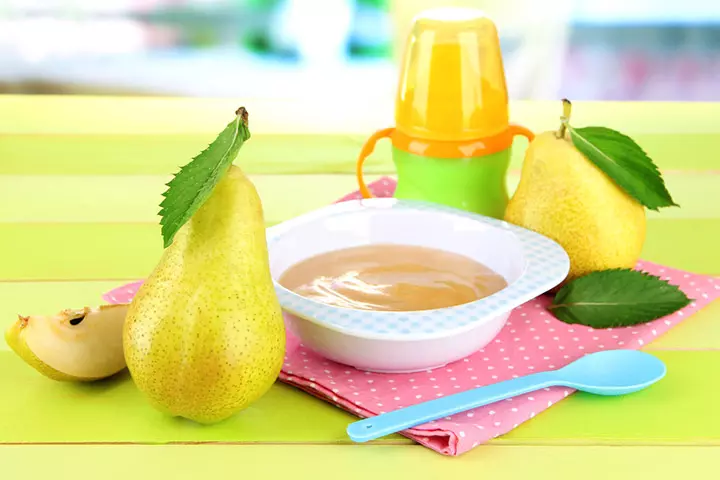
You will need:
- ½ ripe pear (peeled, cored, and deseeded)
How to prepare:
- Steam cook pear pieces in a steamer for five to seven minutes.
- Press the pear slices with the back of a spoon. If the pear mashes easily, the pear is cooked.
- Put the pear into a blender and blend into a smooth-flowing puree. Ensure no lumps are present.
- Pour the homemade puree into a feeding bowl and feed the baby right away. You can add breast milk or formula or water to adjust the puree’s consistency. Serve at room temperature.
You may also use a fruit puree for babies as a safe, frozen dessert option. Judy, a dedicated mother and blogger, freezes the leftover pear puree and serves it as a frozen delight to her baby. She says, “Bebe E really loved this pear purée because it was so sweet. She also liked to eat this when it was partially frozen (like a slushy) and icy cold because it must have been soothing for her aching gums that were working so hard to grow her tiny teeth (i).”
2. Pear and carrot mash (6 months+)
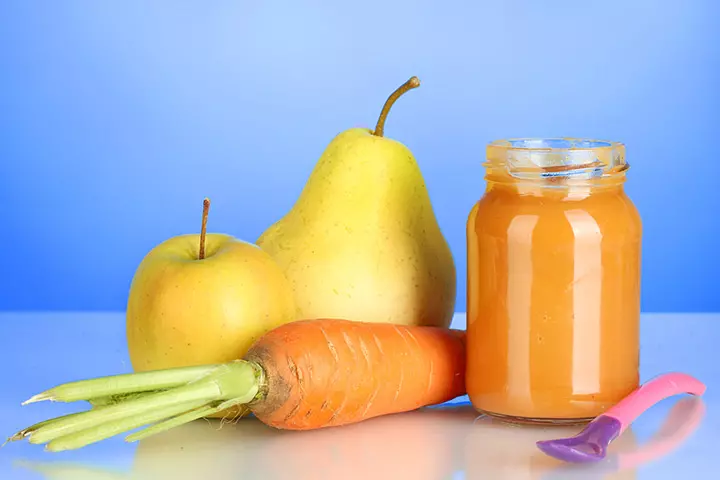
You will need:
- 1 baby carrot (peeled and chopped)
- 1 small pear (peeled, cored, deseeded and chopped)
- ¼ cup water
- ½ tsp jaggery powder
- ¼ tsp cinnamon powder
How to prepare:
- Heat water in a saucepan over a medium flame.
- Put carrot, pears, jaggery, and cinnamon in the pan and cook with a covered lid for about 15 to 20 minutes until the carrot and pear turn mashable.
- After 20 minutes, transfer the mixture to a bowl and mash it into a smooth paste using a fork. Ensure no lumps are present.
- Put some mash into a feeding bowl and feed. If needed, you can use a manual or electric masher to mash the carrots and pear. Check the consistency.
3. Pear porridge (10 months+)

You will need:
- 30g rolled oats
- 1 cup water
- ½ cup breast milk or formula
- ½ cup pear mash
- ¼ tsp dried fruit powder
- Pinch of cinnamon powder
How to prepare:
- Boil water in a saucepan over a medium flame.
- As the water begins bubbling, add rolled oats, cinnamon powder, dried fruit powder, and oats.
- Cook for seven to eight minutes until the oats turn mushy and look well-cooked. Turn off the flame and set the pan aside to cool.
- Stir in pear mash and breast milk or formula. Mix well and see no lumps are present.
- Pour the porridge into a feeding bowl and feed.
4. Pear yogurt (10 months+)
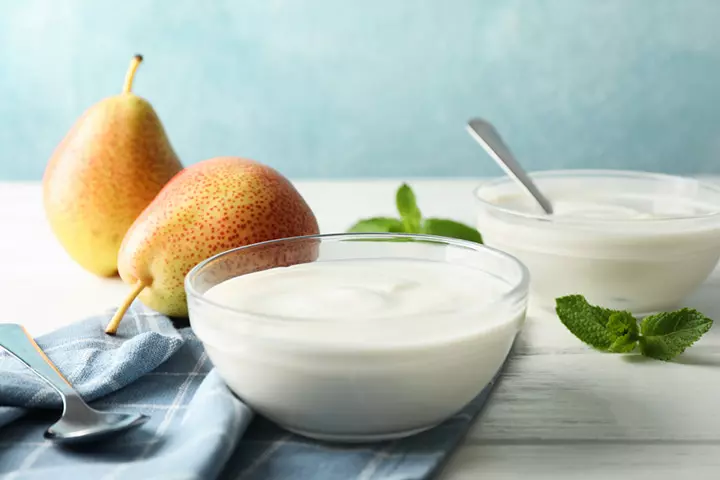
You will need:
- 1 cup unsweetened Greek yogurt
- 1 cup pear mash
- ¼ cup mango pulp
- ¼ tsp jaggery powder
- Pinch of nutmeg and cinnamon powder
How to prepare:
- Put all the ingredients in a bowl and mix well with a spoon. Ensure no lumps are present and check the consistency for smooth chewing.
- Pour the yogurt into a feeding bowl and feed the baby.
 Quick tip
Quick tip5. Pear and butternut squash soup (12 months)
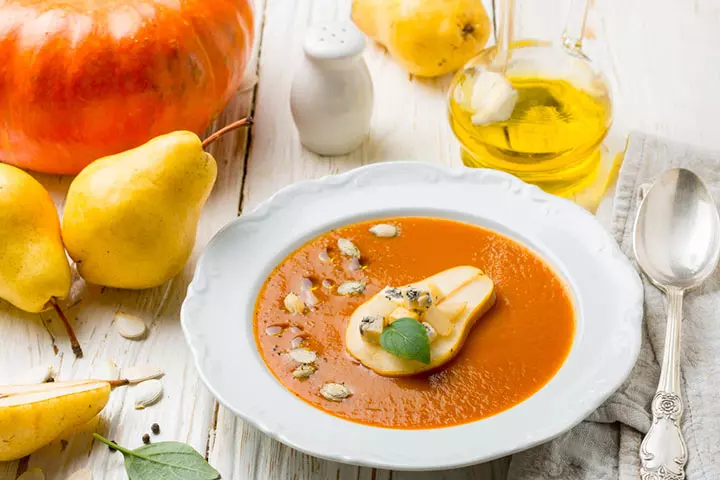
You will need:
- 2 cups low-sodium chicken broth
- 1 cup butternut squash (halved, peeled, and deseeded)
- 1 cup pear (peeled, cored, deseeded, and diced)
- ¼ cup coconut milk
- 1 shallot (quartered)
- 1tbsp fresh ginger (grated)
- ¼ tsp dried oregano and thyme
- Pinch of nutmeg powder
How to prepare:
- Put a slow cooker on a high flame and place squash, pears, shallots, ginger, and broth in it.
- Cook on a high flame for about four hours until it gets soft enough to let the fork pass through.
- After four hours, stir in coconut milk and nutmeg powder. Mix well and set aside to cool.
- Once the mixture cools down, pour it into a blender, and blend into a lump-free, smooth-flowing liquid.
- Pour the soup into a feeding bowl and stir in dried oregano, thyme, and some more nutmeg powder. Feed immediately.
Frequently Asked Questions
1. Is pear easy for babies to digest?
Generally, peeled, ripe pears are easy to digest (11). Hence, they are included in the list of first foods babies can eat (12). While most babies consume pears without discomfort, some may experience gastrointestinal issues. This could be due to its high fiber content or FODMAPs, such as sorbitol, which is linked to diarrhea in children (13).
2. Does pear help in weight gain in babies?
One slice of pear (25g) contains 3.8 grams of carbs (4). Feeding pears to babies can also contribute to their overall energy needs. However, it alone can’t help babies gain weight. If you want your baby to gain weight healthily, feed them a nutritionally balanced diet with several energy-dense, starchy foods, such as bananas and potatoes. Eggs, nuts and seeds, bean soup, and full-fat dairy products, such as Greek yogurt, are protein-rich foods that can help babies gain weight (14).
The recipes suggested for pear for babies are delectable and easy to eat and digest. They provide innumerable benefits to the health of babies as they are a great source of nourishment. Therefore, you must consult your child’s pediatrician to understand how to introduce it to your little one. However, if you ever notice symptoms or allergic reactions after feeding it to the baby, you must stop and seek treatment to avoid serious complications.
Infographic: More Ways To Include Pears In Your Baby’s Diet
Pears are juicy, sweet fruits that can be cooked in several ways to make delectable dishes for your little ones. Go through the infographic below to learn some tasty recipes and add this nutritious fruit to your baby’s diet. Illustration: Momjunction Design Team
Illustration: Benefits Of Pear For Babies and 5 Easy Recipes

Image: Stable Diffusion/MomJunction Design Team
Indulge your little one’s growing appetite with delightful and nutritious pear baby food using this user-friendly tutorial.
Personal Experience: Source
MomJunction articles include first-hand experiences to provide you with better insights through real-life narratives. Here are the sources of personal accounts referenced in this article.
i. Pear Puree & Laguna Beach.https://bebeloveokazu.wordpress.com/2010/07/12/pear-puree/
References
1. Sun Hwan Bae; Diets for Constipation; NCBI
2. Your baby’s first solid foods; NHS Wales
3. Holly Reiland and Joanne Slavin; Systematic Review of Pears and Health; Researchgate
4. Pear, raw, FDC ID: 1102682; Fooddata Central; USDA
5. Pears, raw; Fooddata Central; USDA
6. Potassium; Oregon State University
7. Milind Parle; Why is pear is so dear; Researchgate
8. Infant Constipation; Healthy Children; AAP
9. Nadja Larsen et al.; Potential of Pectins to Beneficially Modulate the Gut Microbiota Depends on Their Structural Properties; Frontiers In Microbiology
10. Allergy information for: Pear (Pyrus communis ); University Of Manchester
11. Gastrointestinal Soft Diet Overview; Cleveland Clinic
12. Baby’s first foods; Queensland Government
13. Holly Reiland and Joanne Slavin; Systematic Review of Pears and Health; NCBI
14. Safe Weight Gain Tips for Underweight Kids; Academy Of Nutrition And Dietetics
Community Experiences
Join the conversation and become a part of our nurturing community! Share your stories, experiences, and insights to connect with fellow parents.
Read full bio of Seeemaa Budhraja
Read full bio of Swati Patwal
Read full bio of Rohit Garoo
Read full bio of Ghazia Shah






